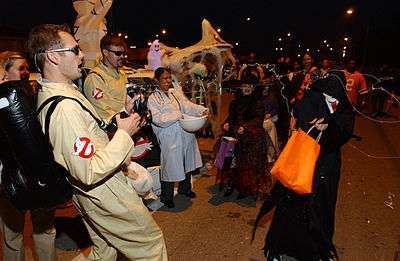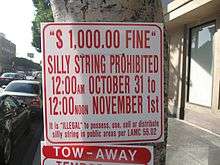Silly String

Silly String (generically known as aerosol string) is a toy of flexible, sometimes brightly colored, plastic string propelled as a stream of liquid from an aerosol can. The solvent in the string quickly evaporates in mid-air, creating a continuous strand. Silly String is often used during weddings, birthday parties, carnivals and other festive occasions, but it has also proven useful militarily to detect tripwires.
Composition
The material is a synthetic-based resin which was originally formulated using the chlorofluorocarbon propellant Freon 12, one of a group of compounds believed to damage the ozone layer. Within a year of Silly String's introduction, the United States banned Freon 11 and 12. The manufacturers then changed the formulation to use permitted propellants.[1]

History
The invention of the original silly string was accidental. In 1972, A United States Patent was issued to Leonard A. Fish, an inventor, and Robert P. Cox, a chemist, for a "foamable resinous composition." The partners initially wanted to create a can of aerosol that one would be able to spray on a broken/sprained leg or arm and use as an instant cast. Their invention worked, but when it came down to packaging the can, the two had to test 500 different kinds of nozzles. After having gone through about 30 or 40, Fish came upon one that produced a nice string, which shot about 30 feet across the room. This incident inspired Fish to turn the product into a toy. After altering the formula to be less sticky and adding colors, the pair decided to market their product. Because neither of them knew how to sell toys, they made an appointment with Wham-O in California. Fish describes how, during that meeting, he sprayed the can all over the person he was meeting with and all over his office. This person became very upset and asked him to leave the premises. One day later, Fish received a Western Union Telegram asking him to send 24 cans of "Squibbly" for a market test immediately, signed by the same individual who had kicked him out. He called them back and explained that, after he had finished cleaning up his office, the two owners of Wham-O had come back to talk to him, and one had noticed a piece of the string on a lamp shade—he had overlooked it while cleaning up. He explained where the string came from and the owners quickly asked him to send samples over for a market test. Two weeks later, Wham-O signed a contract with Fish and Cox to license the product now known as Silly String.
Silly String and its imitators are reputed to be the largest selling novelty toy in the world because people buy multiple cans and use the product quickly. It is polymer-based, likely 11-16% polyisobutyl-methacrylate and 0.5 to 4% sorbitan trioleate dissolved in a solvent that evaporates in the air and acts as a foaming agent. The pressure in the can propels the mixture a distance of up to 20 feet (6.1 m). Other alleged ingredients are a small amount of isopropyl alcohol and plasticizers like dibutyl phthalate.
Silly String was licensed to and produced by Wham-O, in a range of colours including blue, red, and green, until the Car-Freshner Corporation, the maker of Little Trees, acquired the Silly String trademark in 1997. Silly String Products, a division of Car-Freshner Corporation, manufactures Silly String in the United States and distributes Silly String in North America through select big box stores, party supply stores, toy stores and drug stores. The U.S. Patent #3705669 includes a clear description of preferred implementations.[2] Similar toys are Goofy String, Streamer String, Wacky String and Nickelodeon Smatter.
The can is advertised as containing "over 400 feet (120 m) of string." One measurement has shown over 1,600 feet (490 m).[3]
Safety
The composition of Silly String is fairly safe, but the evaporating fluorocarbon solvent can be quite cold, theoretically capable of causing frostbite. The mixture is a very weak skin irritant. The Silly String brand of aerosol string products is advertised as non-toxic and non-flammable, although numerous videos on the internet demonstrate the flammability of aerosol string.
In December 2006, Tween Brands Inc., a retailer of girls' clothing and accessories in the United States, was fined $109,800 by the United States Environmental Protection Agency for "allegedly distributing canned confetti string damaging to the ozone." EPA said the product marketed under various names by the retailer damages the stratospheric ozone layer. The production and use of chemicals harmful to that layer is controlled by U.S. federal law.[4]
Silly String may on rare occasions damage the vinyl surfaces of inflatable structures, upholstery, vinyl wallpaper, and automobile vinyl tops.
Military use
Silly String and similar products have been used by American and British military forces to detect tripwires for explosive booby traps. The string is sprayed over the suspected area, and if the string falls to the ground, no tripwires are present since the string would catch on the tripwires (but is not heavy enough to activate the explosive).[5][6][7]
As of 2006 it was being used by U.S. troops in Iraq for this purpose.[8][9][10] However, because the material is an aerosol, it cannot be shipped privately to Iraq and it is not provided by official channels. Thus, 80,000 cans were unintentionally stockpiled in New Jersey.[11] In October 2007, a shipping company with the required credentials was finally found.[12]

Bans
The use of aerosol string products has been banned in several places for various reasons, including cleanup and removal costs and fears of potential damage to house or vehicle paint.
It has been banned in the city of Ridgewood, New Jersey and a number of other places, and also at some public gatherings and events.[13] The town board of Huntington in Long Island banned the sale of Silly String within 1,500 feet (460 m) of the route of a parade.[14][15] In 2001, the town of Middleborough, Massachusetts banned Silly String; offenders face a $300 fine.[16]
In 2004, Los Angeles Mayor James Hahn signed a council-backed ordinance (LAMC Section 56.02) to ban aerosol string in Hollywood on Halloween night. The ordinance calls for a maximum $1000 fine and/or six months in jail for use, possession, sale or distribution of aerosol string in Hollywood from 12:00 am on October 31 to 12:00 pm on November 1, a 36-hour time period.[17][18]
See also
References
- ↑ Wilson, Tracy. "How Silly String Works". How Stuff Works. Retrieved 13 February 2011.
- ↑ "Foamable Resinous Composition". Google.com. Retrieved 2007-10-16.
- ↑ "Silly String". Cockeyed.com. Retrieved 2007-10-16.
- ↑ "EPA reaches agreement with Tween Brands on clean-air". U.S. Environmental Protection Agency. 2006-12-04. Retrieved 2011-09-27.
- ↑ "Schneier on Security: Military Uses for Silly String". Bruce Schneier. Retrieved 2007-10-16.
- ↑ "Not So Silly String". Kit Up (Military.com). Retrieved 2007-10-16.
- ↑ "N.J. woman collects Silly String for serious use". MSNBC.com. Retrieved 2007-10-16.
- ↑ Martens, Ellin (November 19, 2006). "Not So Silly String In Iraq". TIME.com. Retrieved 2007-10-16.
- ↑ "A Serious Use For Silly String". CBS News. December 6, 2006. Retrieved 2007-10-16.
- ↑ "FOX VIDEO: 'Silly String' is saving lives over in Iraq". The Raw Story. Archived from the original on 2007-10-12. Retrieved 2007-10-16.
- ↑ Applebome, Peter (September 20, 2007). "Toy Goo Might Save Some Soldiers' Lives, but It's Stuck Here". The New York Times. Retrieved 2007-10-16.
- ↑ "Silly String care packages on the way to troops, at last". USA Today. AP. 2007-10-15. Retrieved 2011-09-27.
- ↑ Sanders, Alain L.; Horn, Dara (1998-07-06). "Banned in the U.S.A.". Time. Retrieved 2011-09-27.
- ↑ Morris, DS (March 5, 2008). "Huntington bans Silly String sale near parades". Newsday.com. Newsday.com. Retrieved 2008-03-13.
- ↑ "American towns mull swearing & Silly String bans". Associated Newspapers. Retrieved 2011-09-27.
- ↑ \"Town By-Laws". Bellicose Bumpkin blog. May 9, 2012.
- ↑ "Silly String Banned In Hollywood This Halloween – official website of THE LOS ANGELES POLICE DEPARTMENT". Lapdonline.org. Retrieved 2011-05-15.
- ↑ "Art 6 Ch 5 Sec 56.02" (PDF). Los Angeles Municipal Code. Retrieved June 30, 2013.
External links
| Wikimedia Commons has media related to Aerosol string. |